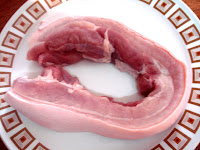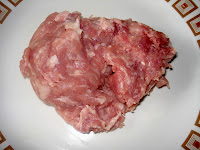
Description: neutral, sweet and salty; affects the stomach, spleen and kidneys.
Pork is the meat from young hogs or domestic swine (6 to 7 months old). The domestication of "pigs" or immature hogs for food dates back to about 7000 B.C. in the Middle East. However, evidence shows that Stone Age man ate wild boar, the hog's ancestor, and the earliest surviving pork recipe is Chinese, at least 2000 years old.
The Chinese prefers eating pork rather than beef because of economic and aesthetic reasons. The pig is easy to feed and not used for labour, and is closely tied with the idea of domesticity that the Chinese character for "home" depicts a pig under a roof. According to the Chinese, the colour of the meat and the fat of pork are more appetizing, while the taste and smell are sweeter and it is easier to digest
However, there are some bacteria associated with pork, which may cause illnesses if the meat is not properly treated or cooked before consuming:
• The pig is the carrier of various helminths, like roundworm, pinworm, hookworm, etc. One of the most dangerous and common is Taenia solium, a type of tapeworm that may transplant to human intestines.
• Trichinosis, also called trichinellosis or trichiniasis, is a parasitic disease caused by eating raw or undercooked pork infected with the larvae of a species of roundworm Trichinella spiralis, commonly called the trichina worm. Infection was once very common, but is now rare in the developed world.
• Influenza (flu) is one of the most notable illnesses, which pigs share with humans. Normally harbored in the lungs of the animal it can affect both the animals and humans. However, the causative organism is found in other animals too.
• Some other food borne microorganisms found in pork, as well as other meats and poultry, are Escherichia coli, Salmonella, Staphylococcus aureus and Listeria monocytogenes. They are destroyed through proper handling and thorough cooking to an internal temperature of 160 °F.
Antibiotics may be given to prevent or treat disease in hogs. A "withdrawal" period is required from the time antibiotics are administered until it is legal to slaughter the animal. This is so residues can exit the animal's system and will not be in the meat.
Pork is classified a "red" meat because it contains more myoglobin than chicken or fish. Red blood cells delivers oxygen to the muscles and one of the proteins in meat, myoglobin, holds the oxygen in the muscle. The amount of myoglobin in animal muscles determines the color of meat. When fresh pork is cooked, it becomes lighter in color, but it is still a red meat. Pork is leaner than most other domesticated animals but consuming excessive amounts of pork may lead to gallstones and obesity due to its high cholesterol and saturated fat content.
Buying tips
When buying pork, look for cuts with a relatively small amount of fat over the outside and with meat that is firm and a healthy pink color. For best flavor and tenderness, meat should have a small amount of marbling. Avoid anything looking damp or clammy, or with oily or chalky-looking fat.
Storing and freezing
Cover and store raw and cooked foods separately. Store raw foods below cooked foods in the fridge. Pork will keep for three to five days in the fridge. Use mince, offal and smaller cuts within one to two days of purchase.
Quickly freezing pork reduces the chance of damage to its texture or succulence. Use frozen pork within six months.
There are three safe and proper ways to defrost pork:
• in the refrigerator. Once the raw pork defrosts, it is safe to keep in the refrigerator an additional day or two before cooking.
• in cold water in its airtight packaging or in a leak proof bag.
• in the microwave. Pork defrosted in the microwave should be cooked immediately after thawing because some areas of the food may become warm and begin to cook during microwaving.
Never defrost pork on the counter or in other locations. Always plan ahead for slow, safe thawing in the refrigerator. During this time, if the pork is not used, it is safe to refreeze without cooking first. Foods defrosted in the microwave or using the cold water method should be cooked before refreezing.
Cooking Tips
Wash the cut pork pieces with a handful of salt to remove the smell.
Blanch any boney pieces of pork before cooking to remove the scum.
Below are various types of cuts

pork belly strip

pork bone without meat

pork bones with meat

pork ribs

minced pork

lean pork and liver

chinese pork sausages. The little ones are much tastier because it has wine in it.
Cooked pork

Chinese roast pork belly

char siu
No comments:
Post a Comment